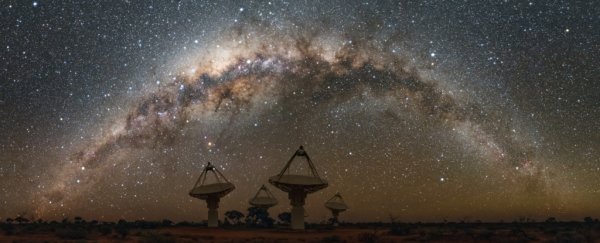Strange, powerful signals from deep space called fast radio bursts are slippery little suckers.
Most of them just flash once, a mysterious huge spike in the radio data out of nowhere, lasting just milliseconds at most. They can't be predicted, and because they're so brief, they're incredibly hard to trace.
Hard; but not impossible. Less than a year ago, for the first time, astronomers announced they traced one of these mysterious one-off signals to its source galaxy. Since then, their techniques have allowed them to trace three more.
And this has now given us one of the keys that help us unlock the mystery of what fast radio bursts are - a census of the galaxies that spat them out across the Universe.
"Just like doing video calls with colleagues shows you their homes and gives you a bit of an insight into their lives, looking into the host galaxies of fast radio bursts gives us insights to their origins," explained astrophysicist Shivani Bhandari of the Commonwealth Scientific and Industrial Research Organisation (CSIRO) in Australia.
Ever since the fast radio bursts were discovered in 2007, astronomers have been itching to find out what causes them. They're just so cool and weird - a flash of radio waves that lasts the blink of an eye, with the power of hundreds of millions of Suns.
We're not sure what causes them - indeed, it could be more than one thing - but possible explanations to date include:
- neutron stars
- black holes
- pulsars with companion stars
- imploding pulsars
- a type of star called a blitzar
- a connection with gamma-ray bursts (which we now know can be caused by colliding neutron stars)
- magnetars emitting giant flares
- and aliens (it's not aliens)
Most of them are one-off signals, but a small number have repeated, which has allowed scientists to trace them back to a source galaxy; to date, two repeating fast radio bursts have been localised this way.
They emanate from two very different kinds of galaxies, and different regions in those galaxies, but they have one thing in common: they both come from regions with intense star formation.
The first analysis of the galaxies that produce one-off bursts paints a very different picture.
Using a special detector in the Australian Square Kilometre Array Pathfinder array, Bhandari and her team localised four one-off fast radio bursts - FRB 180924, FRB 181112, FRB 190102 and FRB 190608 - with much greater precision.
 (Bhandari et al., ApJL, 2020)
(Bhandari et al., ApJL, 2020)
All four were from galaxies up to billions of light-years away. At that distance, individual stars are impossible to pick out, so we could never use this technique to identify single FRB objects.
But the environments can be important - for instance, if they're in extreme environments near black holes, or if they're from 'dead' galaxies, that can tell us what kinds of objects we're most likely to find. And this research is a case in point.
"These precisely localised fast radio bursts came from the outskirts of their home galaxies, removing the possibility that they have anything to do with supermassive black holes," Bhandari said.
In fact, all four galaxies are a lot like our Milky Way. They're relatively large and forming stars at a pretty modest rate, in contrast to the two galaxies that appear to be the source of the repeating fast radio bursts.
The types of stars that populate galaxies like these also rule out a few possible sources. While magnetars are still a possibility, the galaxyies the one-off fast radio bursts are coming from rule out specific magnetars that are theoretically produced by superluminous supernova explosions.
But it still leaves a few models that can be explored.
"Models such as mergers of compact objects like white dwarfs or neutron stars, or flares from magnetars created by such mergers, are still looking good," said astrophysicist Elaine Sadler of CSIRO.
The similarity of those four galaxies to the Milky Way has another implication, too.
Earlier this year, a magnetar in our home galaxy was detected flaring shockingly similarly to a fast radio burst for the first time.
If all four FRBs studied by Bhandari's team had come from small lenticular galaxies, or starburst galaxies, that would dampen the possibilities associated with that detection. But the fact that they haven't is good news on the magnetar front.
We're not quite at the point yet where we can make an absolute declaration on what causes fast radio bursts. Science is often painstaking work, like building a wall - brick by brick, until the whole thing becomes clear. This research is a pretty important brick.
"Positioning the sources of fast radio bursts is a huge technical achievement, and moves the field on enormously," said astrophysicist Dame Jocelyn Bell Burnell, who discovered pulsars in 1967, and was not involved in this research.
"We may not yet be clear exactly what is going on, but now, at last, options are being ruled out. This is a highly significant paper, thoroughly researched and well written."
The research has been published in The Astrophysical Journal Letters.
